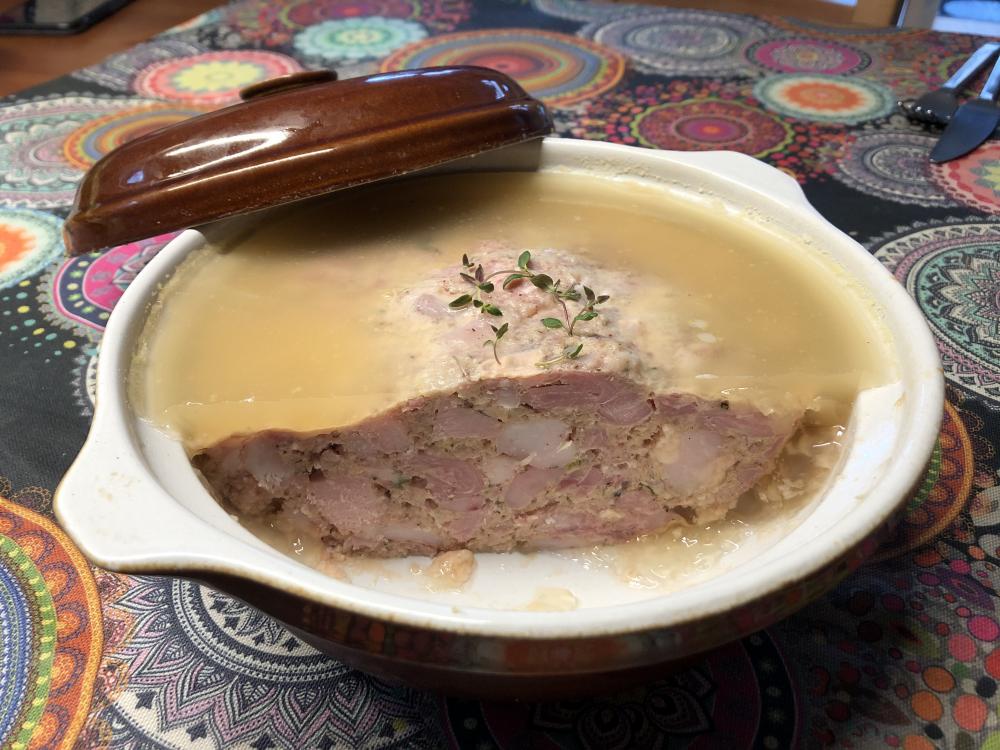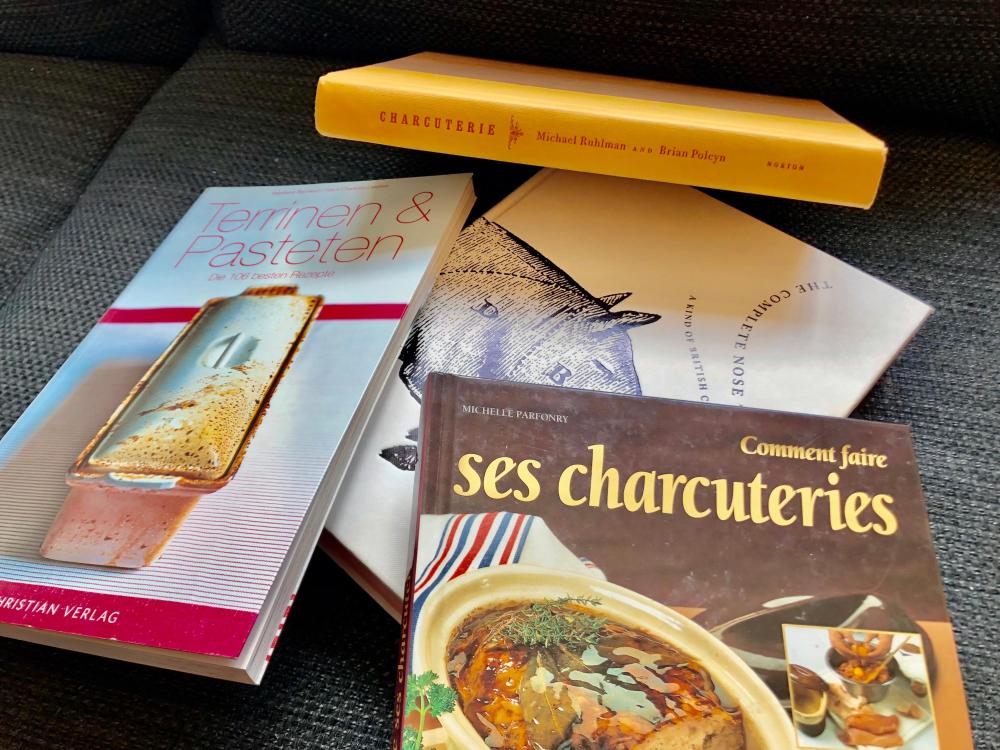Search the Community
Showing results for tags 'Cookoff'.
-
Every now and then since December 2004, a good number of us have been getting together at the eGullet Recipe Cook-Off. Click here for the Cook-Off index. For our ninth Cook-Off, we're going to be making Mole Poblano de Guajolote. If you're like me, you can't get decent mole poblano where you live; instead, you get the "Mexican" equivalent of Hershey's chocolate syrup, which is sure to make you wonder what the fuss is all about. But if you've ever had the rich, piquant, incredibly complex sauce made from dried chiles, spices vegetables, nuts, seeds, lard, stock, and chocolate... well, you're in for a treat. You're also in for an absurdly long list of ingredients and a substantial simmering time. But it's worth it, trust me -- and what other dish might get you seriously thinking about how delicious turkey is in May? As usual, our eGulleteer forebears have done a lot of good work for us. Here's a thread on mole poblano, a great tamale thread with Abra's mole photo essay, and a more expansive, and a bit older, mole thread. Starting researching recipes and sourcing ingredients people!
-
We were wondering what a good next cook-off would be when Restaurants and Institutions posted this list of the Top 10 Most Googled Recipes of 2009. We compared it to our eG Cook-Off Index and realized that we'd hit most of those main dishes save one. So: Welcome to the latest eG Cook-Off 52, lasagna! We've had a few discussions on the dish (click here and here) but long ago. Given the poke from Restaurants and Institutions, it seemed an update was in order. I've often made both the bolognese & bechamel version as well as the Italian-American red sauce & ricotta, mozzarella, and parmiggiano version, and I love 'em both. I'm also a convert to using as many fresh ingredients as possible, most especially the pasta itself. With kids in the house, it's a fun dish to assemble, and they wolf it down. So is anyone up for some lasagna al forno?
-
Welcome to eG Cook-Off 53, grilled chicken! (For previous Cook-Offs, check out the eG Cook-Off Index.) For such a ubiquitous summer protein, there have been few eG Forums topics on the subject. CDRFloppingham asked us to consider his grilled chicken dilemmas over in this topic, and there have been a few discussions about par-cooking chicken prior to grilling, a recent long one here and a brief excursion into the topic here (during the Cradle of Flavor topic). But parcooking is just the tip of the wing. Rubs or marinades? Gas or charcoal? Direct or indirect? Whole, spatchcocked, or parts? When do you add salt? Acid? Anyone want to drag the grill out and throw a few birds on it? Just keep your hands off the charred skin I "accidentally" pulled from that stray thigh....
-
Welcome to the eGullet Cook-off 54: Gratins. Click here for the Cook-off index. Now that we're all battening down the hatches to wait out winter in our kitchens, it seems like a good time to consider the gratin. It's cold outside; the shops are filled with reasonably-priced root vegetables; and we can still kinda-sorta justify calorie-dense dishes that help us maintain our winter weights. Gratins are not something I knock out much in the kitchen, so I've had a look in my Larousse to get a starting point: Gratins have been discussed before, but we've never done a cook-off to properly get under the "skin" of this dish, if you will. RecipeGullet is full of recipes from our members: Fifi gave us Fifi's Favourite Eggplant Gratin; jackal10 contributed quick potato gratin a la dauphinois; Dave the Cook saw his quick potato gratin and raised it to a Really Simple potato gratin; and even Russ Parson's weighed in with his mushroom and spaghetti squash gratin. Shalmanese has asked about non-soupy cauliflower gratins; Chris Hennes has yearned to know why his gratin broke. Kim Shook just plain feels she's gratin-challenged. There's lots for us to discuss with regards to gratin: meat or vegetables? What kind of cheese? How about breadcrumbs? Do you use cream? Do you have a special gratin dish, or do you just use a casserole? Let's get layering. Allez gratin!
-
Welcome back to our reknowned eGullet Cook-Off Series. Our last Cook-Off, Bolognese Sauce, led to a spirited discussion over the intricacies of the beloved Italian meat sauce. Click here for the complete eG Cook-Off Index. Today we’re launching eGullet Cook-Off 58: Hash, the classic American diner dish. Yet what appears as a humble, one-name dish is anything but ordinary. The difficulty in defining “Hash” is exactly why we’ve chosen it for a Cook-Off—simple definitions don’t apply when one considers that Hash is a dish that transcends regional and international boundaries. The ingredients one chooses to put into their version of Hash are limitless--we aren’t just talking cold meat and leftover potatoes folks. I for one, always thought Hash came out of a can from our friends at Hormel Foods, (as in "Mary Kitchen" Corned Beef Hash). It looks like Alpo when you scoop it out of the can, but it sure fries up nice and crispy. After a few weeks of research in the kitchen, I’ve experienced a new appreciation for Hash. So start putting together the fixins for your Hash and let’s start cooking. Hash, it’s what’s for breakfast, brunch, lunch and dinner.
-
Welcome to the eGullet Cook-off 55: Shrimp & Grits. Click here for the Cook-off index. Let's just start with a shameful fact: until this moment, eG Forums has had no topic dedicated to making this classic southern dish. True, there's this rambly topic on the origins and particulars of shrimp & grits, and this one on a shrimp & cauliflower "grits" project by Chappie, and a couple dozen on grits basics. But nothing focused on preparing shrimp & grits. Perhaps this is because many think of it as a dish without need for specificity or even care. I mentioned to someone recently that I had to do some prep for a shrimp & grits dinner; he retorted, "How much prep is there?" I suppose you could toss some grits into boiling water, toss some shrimp into a skillet, dump B onto A and call it done. But that seems unfair, doesn't it? The grits below can be a simple foil for dolled-up shrimp, or they can be the luxurious star, creamy, cheese-y, and more. Additional ingredients, garnishes, and accompaniments vary widely, too. If you've had a top-notch version of the dish, you know it isn't just, well, shrimp & grits. Even this Yankee knows that it's good for what ail's you, late winter blues included. So let's see what your basic recipe is, and then you can show us what you do to kick things up a notch. So to speak.
-
Welcome to the eGullet Recipe Cook-Off! Click here for the Cook-Off index. This time, we're focusing on cold noodles, suggested by Society Member "Hiroyuki" as a great way to beat the Summer heat. Some version of a cold noodle dish can be found in virtually any cusine in the world. Whether you've wanted to try your hand at Somen (Japanese cold noodles), Nang Myung (Korean), or Aunt Irene's Cold Pasta Salad let's go for it! Let's talk about the various types of noodles and each one's virtues! Homemade vs. dried? Dressings and additions? Nosing around the forums brought up several topics: "Pasta Salad" the topic "Cold Noodles w/ Szechuan v. Dan Dan Mein" "Pasta Salad for Father's Day" "Pasta Salad lacking Nuance" "Nyang Mun (Naengmyun) Korean cold noodle dish" RecipeGullet offers these great looking recipes: "Cold Peanut Noodles" "Orzo Salad with Apricots" "Curried Macaroni Salad" I am not familar with anything other than cold pasta salad with ranch dressing dumped on it (I know, I know, but my kids consider it the required side dish for BBQ) - so I am looking for cookbooks that can help me out. I am considering the following: "The Noodle Cook Book: Delicious Recipes for Crispy, Stir-Fried, Boiled, Sweet, Spicy, Hot and Cold Noodles" by Hayto Kunumi "Noodle" by Terry Durack and Geoff Lung "James McNair's Cold Pasta" by James McNair "Garde Manger, The Art and Craft of the Cold Kitchen" by The Cuinary Institute of America Any other good cookbook suggestions out there? Who's up for some cold comfort in July?
-
Welcome to this edition of the eG Cook-Off! Click here for the eG Cook-Off index. This time around, paella is going to be on the table. I've had it but once or twice, and this eG Cook-Off now a bit about preparing it -- what to include, what to exclude, what kind of rice to use, and the appropriate cookware. There is a bit of stuff floating around here on making paella, including the Paella topic, one on fideua (a noodle paella) and a couple on paella pans (one on carbon steel vs. stainless steel and another on smooth vs. pebbley interiors). There's also a recipe in RecipeGullet for Rice with Salt Cod, Chickpeas and Red Peppers and one for a Seafood Paella. Then, there are books about paella. The first one that came to mind was one I saw at the library a few days ago: Paella!: Spectacular Rice Dishes From Spain by Penelope Casas. There's also La Paella: Deliciously Authentic Rice Dishes from Spain's Mediterranean Coast by Jeff Koehler. I know nothing about cooking paella, just that I like it! For starters, do I really need to buy a paella pan for something I won't cook very often? Are there absolutely required ingredients?
-
Pâtés & Terrines What can be more inviting than a slice of a carefully balanced, well spiced and rich pâté, perhaps with a fresh tart side salad and a warm crusty bread? Well, you’ll soon be in for exactly that treat: welcome to eGullet Cook-Off #89 - Pâtés & Terrines! Although at first glance* a bit more technical & complex than our previous wings topic, it offers plenty of space to explore and experiment: from a simple pâté de campagne to a foie gras-centered pâté en croute with a delectable pasty shell and a jellied Sauterne cover. There has been a longstanding topic on terrines with spectacular entries in the past, so we felt it would be more than justified to open the topic up for a spirited exchange in the course of our popular Cook-Offs. Typically something rather enjoyed in a restaurant setting (where these time-consuming, yet economical preparations have undergone a renaissance due to the nose-to-tail movement) or as a treat from your deli or traditional butcher, pâtés and terrines are surprisingly not difficult to prepare. They make – however – usually more than two servings, so maybe the upcoming Easter holidays could help to encourage you to give it a try and surprise your family and friends** … There are many definitions of what makes a pâté a pâté, and how and why terrines are different. I am happy to discuss with you the intricacies of these, but for setting a non-threatening starting point I’d like to think of both as a fancy meatloaf or maybe an oversized sausage (in a funky rectangular shape perhaps) with interesting, maybe surprising additions (such as liver, offal, nuts, dried and alcohol-soaked fruits), herbs, liquors and spices (quatre épice anyone?). What kind of meat do you prefer? The world is your oyster, and beside all types of game, domestic animals, poultry and fowl, fish & seafood (including said oyster) can be used as well. Do you like a smooth texture or a coarser product, maybe with inlays ? You can shape your loaf into animal shapes, wrap it in bacon, fatback or puff pastry perhaps and glaze it with any gelled liquid you fancy. I can already see your minds starting to get creative … Rabbit terrine from the Rabbit Cook-Off. So break out your books and magazines, peruse your favourite websites and maybe even show off tried & trusted family recipes and show us what you are capable of – if you can get ground meat and have an oven*** I’ll repeat my mantra: there is really no excuse this time 😊 See the complete eG Cook-Off Index here: https://forums.egullet.org/topic/143994-egullet-recipe-cook-off-index/ —- * well – having seen how much work can be put into a humble chicken wing, only at first glance. ** they make a terrific presents as well. *** or sous-vide setup, or …
-
We were driving through Southeast Washington when suddenly Marnie shouted, "look, there it is, stop the car!" Needless to say, we were all a bit stunned and thought there must have been some critter scooting across the highway. And then I saw it for the first time: asparagus. It was decades ago, but every spring I relive the memory of seeing asparagus growing for the first time. Our family had been at a horse show in Pasco, a town in the Columbia River basin in South-Central Washington. We decided to drive over to Walla Walla, the heart of Washington's asparagus fields, to visit Whitman College. Mother had graduated Whitman in 1946, and we were taking our family friend Marnie to visit campus where she would start her freshman year in the full. It was then that I fully understood why asparagus--seasonal, local asparagus--is a prized delicacy of spring. I had the idea it grew on a bush. Or maybe it grew in some sort of cluster, cloaked within a heavy blanket of outer leaves like cabbage or cauliflower. Yet there it was, one stalk at a time, bursting up through the rich soil fed by the Columbia River. Rows and rows of single stalks of asparagus standing in a perfect line. Given Mother's ties to Whitman College and Walla Walla, the role that asparagus would play in shaping our family's tastes for this special vegetable should have been easy to predict. (As an aside, Walla Walla is also the home of the "Walla Walla Sweet" onion. Mother used to tell us she loved a raw Walla Walla sweet sandwich on white bread with mayonnaise). Now I'm sure you've got your own culinary memories and favorite asparagus dishes to tempt us. So today we'll begin eG Cook-Off #77: Asparagus, the Spear of Spring. (See the complete eG Cook-Off Index here.)
-
Consider, if you will, the Schnitzel. The national treasure of Austria, the word Schnitzel is a diminutive of the word “sniz” or “slice.” A piece of meat, pounded thin, then coated in bread crumbs and fried. Traditionally served simply with slices of fresh lemon, a sprinkle of paprika and maybe a leaf or two of parsley. Dating back to about 1845, the most famous of the schnitzels is the Wienerschnitzel (the Swiss break it into two words-Wiener Schnitzel), always made with veal. But the Wienerschnitzel we are discussing must not, in any way, be confused with the fast food chain "Der Wienerschnitzel", founded in California in 1971, and to this day selling "wieners" - a.k.a. hot dogs - under a pseudo-Austrian affectation. Opened in 1905 by Johann Figlmüller in the heart of Vienna, restaurant Figlmüller Wollzeile has been known as the “Home of the Schnitzel.” Serving massive portions of schnitzel draped over plates and served with a side of Austrian potato salad. Schnitzel isn’t always made with pork. Nor is it always breaded and fried as we know it. Take the Walliser Schnitzel for example. A pork escalope with a pocket stuffed with dried apricots sautéed in white wine with ham, parsley, cheese and almonds. The Walliser schnitzel is brushed with a tangy mustard but never coated in breadcrumbs and fried in sauté pan in a shallow pool of butter. If you’ve ever trekked through the cities, towns and fairs that dot the state of Iowa, you’ve surely come across the beloved tenderloin sandwich. A large slab of thin pork, dipped, breaded and fried, then placed between a bun that covers literally a few inches of the beast. A Schnitzel sandwich if you will. Served dry, with mayonnaise, maybe a few dill pickle slices and you're tasting a slice of America's heartland. Tradition tells one that Schnitzel can also be made with mutton, chicken, pork, beef, turkey or reindeer. Today one could stretch the idea of the protein to include a “Tofu Schnitzel” perhaps topped with a spiced mixture of lentils and harissa. I happen to live in the Pacific Northwest where it is common for hunters to craft a schnitzel from venison or elk, the perfect treatment for lean wild game that doesn’t need more than a kiss of the hot skillet to get crispy. Now the dip and fry are constant points of the schnitzel debate. Dipped in flour, then egg, then bread crumbs is the primary technique. Or is that egg mixed with milk, or condensed milk? Is it a double-dip in the flour and egg? And do we use fresh bread crumbs, panko or bread crumbs with parmesan? Wouldn’t pork lard be the best fat for frying a pork schnitzel? Or do we use butter, shortening, canola, vegetable or olive oil? As you can see we have some work to do here. Welcome to eG Cook-Off #76 and Consider the Schnitzel. (See the complete eG Cook-Off Index here.)
-
Welcome back to our eGullet Cook-off Series. Recent Cook-Offs challenged our skills with Grilled Chicken, Gratins, Shrimp & Grits and Savory-Filled Pastries. (Click here for the Cook-Off Index). Today we’ll be launching eGullet Cook-Off 57: Bolognese Sauce. We've discussed Bolognese in the past here, but let's revist this classic dish and get into the heart,(with lots of discussion and photos), of one of the most traditional of all Italian sauces. Bolognese Sauce, (often called “Ragu” Bolognese), dates back literally hundreds of years to the 5th century when the Romans were in power. Yet the historical records as to who actually created Bolognese Sauce are somewhat sketchy. Even more unclear is the question as to what is the “definitive” Bolognese Sauce. The argument over the ingredients that go into a Bolognese is probably as deep as the complex, rich flavors of this classic sauce. As with many legendary recipes, there are literally thousands of variations of Bolognese-the meat, the vegetables, the spices, the “tomato” element and the pasta are all points for heated discussion and that’s exactly why we’ve chosen Bolognese sauce for our latest Cook-off. Along the way, I’ll be sharing a few suggestions for Bolognese from a James Beard Award-Winning Chef known for his expertise in Italian cuisine. Start scribing your shopping list and assembling your ingredients and let's get in the kitchen and cook some Bolognese Sauce.
-
Welcome back to our popular eGullet Cook-Off Series. Our last Cook-Off, Hash, took us into a heated discussion of the meat of the matter--should it be chopped, hashed, sliced, diced, or chunked. Click here, for our Hash discussion, and the answers to all of your questions about this beloved diner staple. The complete eG Cook-Off Index can be found here. Today we’re launching eGullet Cook-Off 59: Cured, Brined, Smoked and Salted Fish. Drying fish is a method of preservation that dates back to Ancient times, but more recently, (let’s say a mere 500 years ago or so), salt mining became a major industry in Europe and salt was a fast and economical way of preserving fish. Curing agents like nitrates were introduced in the 19th century, furthering the safety and taste of preserved fish. Where I live in the Pacific Northwest, Native Americans have been preserving fish and seafood for millennia. While we are best known for our ruby-red, oily-rich, smoked salmon, other species of fish found in the Pacific and in our streams are delicious when cured and smoked including Halibut, Sablefish and Idaho Rainbow Trout. And don’t think that you can’t smoke shellfish, alder-smoked Dungeness Crab is a wondrous Pacific Northwest delicacy that evokes memories of crab roasting over a driftwood fire on the beach. Another method of preserving fish is to bath the beauties in a brine—a combination of water, sugar, salt and spices that adds flavor and moisture to fish before it is dried or smoked. And speaking of smoked fish, you can do it in a small pan on top of the stove, in a cast iron drum, a barbecue pit, an old woodshed or a fancy digital smoker. The methods and flavors produced by smoking fish are endless. Old-fashioned ways of preserving fish, (while adequate at the time), aren't always the best method today. Today's technology provides us with the tools to create cured fish that is moist, succulent, tender and with a hint of smoke. The Modernist movement has certainly played a role in bringing this age-old craft into the 21st century, so for the avant-garde in the crowd, show us your creative wizardry for preserving fish the "modern" way. Cured, Brined, Smoked or Salted, the art of preserving fish opens us up to limitless possibilities that transcend the boundaries of cuisine and culture. So let’s sew-up the holes in our fishnets, scrub the barnacles off the rowboat and set out to sea in search of some delectable fish to cure, brine, smoke and salt.
-
Welcome to the 2013 kick-off of our popular eG Cook-Off Series. In 2012, our Cook-Offs ran the gamut from “Hash,” to “Cured, Brined, Smoked and Salted Fish,” onto “Banh Mi” and ending the 2012 season with a discussion of “Gels, Jell-O, Aspic.” (Click here http://forums.egullet.org/topic/143994-egullet-recipe-cook-off-index/ for the complet eG Cook-Off Index). I made a personal discovery during our “Gels, Jell-O, Aspic” Cook-off. I found a little metal Jell-O mold on a dark, back shelf in a kitchen cupboard. That little mold led to a cherished family memory and became the vessel that would hold one of the most delicious dishes I’ve ever crafted. (Click here http://forums.egullet.org/topic/143597-cook-off-61-gels-jell-o-and-aspic/ to read about the delicious jiggly dishes we created). Today we’re going to venture into the depths of a discussion about a sea-dweller that is so scary looking to some they refuse to eat the delicious little devils. The horrors of being presented with a steaming bowl of soup with little appendages peeking out. Join in and let’s put forth our very best “Squid, Calamari and Octopus” dishes. Knowing your passion for cuisine, I don’t expect to see squid rings coated in gummy batter and deep-fried to the point that they bounce on the floor like a rubber ball. No, I’m guessing we’ll plate some fabulous dishes that showcase the versatility of these unique creatures.
-
Every now and then since December 2004, a good number of us have been getting together at the eGullet Recipe Cook-Off. Click here for the Cook-Off index.. Oh, those little dumpling pillows filled with broth! They are a favorite at dim sum places, and it's time we tried our hand at making them. There are many topics on where to get the best ones in different cities and a few on making your own (and there seem to be many different spellings on these lucious dumplings): Xiao Lun Bao/ Soup Dumpling Recipes Soup Dumplings (Xiao Long Tang Bao) Xiaolong Bao Little Steamed Juicy Buns Let's talk filling, technique, wrappers, and just how to get those perfect topnots, and then let's eat!
-
Cold Soups--Cook-Off XL eGullet Recipe Cook-Off Series Welcome to the eGullet Recipe Cook-Off! Click here for the Cook-Off index. From avocado to zucchini, cold soups know no bounds. And, with summer quickly approaching in the northern hemisphere, we thought it might be a good time to take a look at all the wonderful varieties of cold soups that work so well in the warmer months. After all, who doesn't remember that wonderful first slurp of an icy, spicy gazpacho? Or mixing your side of sour cream into a shockingly red borscht for a dish that is so much more than the sum of its parts. Perhaps yours was fancier, the potato and leek wonder known by its French name, vichyssoise...(and which, by the way, is also known as potage parmentier when served hot, according to Bernard Clayton, in his great primer The Complete Book of Soups and Stews; Clayton's book has 29 cold soup recipes - not bad). Stepping back in time, if you'll allow me to poach a couple of cold ones that I made last year, there's ample room for sweet as well as the savory. Strawberries make an awesome soup, or so I'm told. Cherries do too - just take a look below...this sour cherry soup was quite tasty, as well as a great vehicle for ice cream and sorbet ... Perhaps something a little more savory is to your liking...everyone loved cacik, a Turkish yogurt and cucumber soup, redolent with dill and garlic...though I may have served portions a bit too large - So, bring it on eG'ers - get out your blenders, hand mixers, food processors, chopping blocks, ice cubes, etc. and show us what's keeping you cool, at least in the soup department, this coming summer.
-
Welcome to the eGullet Recipe Cook-Off! Click here for the Cook-Off index. A couple of days ago, we were trying to figure out a good cook-off topic for late April/early May, and someone suggested tacos. Shortly thereafter, Mark Bittman of the New York Times decided to weigh in with this article, titled "Sunday Morning, Yucatán:" Bittman shares three recipes, as well, for Taco Filling With Poblano Strips and Potatoes, Mushroom Taco Filling, and Nopales Filling. Meanwhile, over at Bon Appetit, Steven Raichlen writes about the food of the Yucatan, including, naturally, tacos. Finally, someone pointed out that the 5th of May was coming -- you know, Cinco de Mayo. So tacos it is: soft or hard, corn or flour, meat, fish, or veg. As always, we've got a few topics to get us started, including these on tacos al pastor, how to create a DIY taco stand, cabbage in tacos, and fish tacos. There are also tortilla recipes here and a reheating tortillas discussion here. From cheap on the low-down to gussied-up, tacos run the gamut. What are your go-to recipes? Any that you've been dying to try? You can do better than a big fast food chain place, even if you want that ground beef Tex-Mex style of taco. Let's get cooking.
-
Welcome to the eGullet Recipe Cook-Off! Click here for the Cook-Off index. Perhaps the most internationally well-known food from Jamaica involves the spicy dry-rub Jerk seasoning, cooked in a 55-gallon drum converted into a charcoal grill, and served screaming-hot as street food across the island. While most of us don't have 55-gallon drums in our backyards, jerk-style meats (and even tofu!) are perfect for outdoor grilling, and (in a pinch) roasting for those without access to a grill. The recipes in RecipeGullet have the common theme of Allspice and Scotch Bonnet peppers, in addition to the inclusion of scallions, garlic, nutmeg, cinnamon, etc. We have a recipe for Jerk Chicken and for Jamaican Jerk Paste which it seems can be readily adapted to nearly any protein, with pork, goat, and chicken being the best-known examples. In addition, entire cookbooks exist dedicated to the subject—Jerk from Jamaica: Barbecue Caribbean Style, for example. Here on the eGullet Forums we have topics devoted to Jerk Chicken, Jerk Sauce, Jerk Pork, a discussion on the authenticity of using Soy Sauce in Jerk, and even some advice on Oil Drum Cooking. What is your "house blend" of Jerk spices? Soy Sauce included, or sacrilege? Doin' your thing over gas, or burning Pimento Wood, or living in an apartment with no grill and winging it?
-
Welcome to the eGullet Recipe Cook-Off! Click here for the Cook-Off index. There was this rat, and he wanted to be a cook. When he finally made it into the kitchen of a Parisian restaurant, he needed some help coming up with a signature dish to impress the critics. So he sent his producer to stage a few days at the French Laundry, a little-known, out-of-the-way joint run by a guy named Thomas Keller. Keller had come up with a dish he called "byaldi," and with a bit of tweaking, handed over a recipe for Thomas Keller's "confit byaldi." Rat made it, critic was thrilled, everyone's happy. A little while later, this eGullet Society member, KarenM, prints out the recipe and makes this thing of beauty: Fortunately, there were many dozen grateful Heartlanders eager to devour the dish, which some of them called by its ancestral name: ratatouille. Ratatouille is the perfect late summer Cook-Off. Shockingly, we have only one topic dedicated to it, but it's a beaut. You'll find disagreements about whether ratatouille should be a jammy, stewy ratatouille or a discretely sautéed and layered dish. Advocates of Provencal authenticity face off against the fresh, clean, and bright brigade who know no region. And then there's that picky olive oil question. I'll admit that I've always hated ratatouille, which has been throughout my life the potluck dish I should avoid at all costs, so I'm game to figure out how to make something that doesn't suck. I also have no fear of the mandoline, if it comes to that. So where do you stand? Jammy goodness or definitive elements? Are you a Provencal stickler or a "what's ready in my garden" free spirit?
-
Welcome to eG Cook-Off 46! Click here for the Cook-Off index. We spent the last Cook-Off perfecting french fries, delightful yet leaning toward the one-dimensional. This time we're shifting gears and making the multi-dimensional Mexican dish, enchiladas. The variations on enchiladas are endless-there doesn't seem to be one "definitive," classic, enchilada recipe. They can be filled with beef, pork, chicken, smoked duck, smoked turkey or steamed octopus. An enchilada might be slathered with melted cheese, sprinkled with queso fresco, or have no cheese at all. It seems as though the only thing that enchiladas have in common is that all versions are wrapped in some type of tortilla. There are lots of possibilities for saucing an enchilada, everything from what one finds in a can on the supermarket shelf to homemade salsas using dried chilies. And of course, the variety of dried chilies to use for the sauce -- from mild to devil hot -- is also endless. In her definitive Art of Mexican Cooking, Diana Kennedy describes the two methods for making enchiladas. In one, you lightly fry the tortilla before dipping it into sauce; the process is reversed in the other. For both versions, you then fill the sauced and fried tortilla and roll it up. Kennedy's enchiladas placeras are sauced with a garlic, serrano, and tomato salsa and then filled with shredded beef; her enchiladas de Santa Clara uses an ancho and garlic sauce and an egg and cheese filling (and sounds delicious). Enchiladas benefit from corny, lardy homemade tortillas but also can mask mediocre ones to good effect, and they are an excellent way to showcase a perfect salsa. The previous main enchilada topic can be found here. You can also find topics on making tortillas at home here and a pictorial topic on Making Mexican at home is here. I've eaten hundreds of enchiladas in restaurants, but I was never able to duplicate that "restaurant-quality" enchilada flavor at home. My tortillas were either mushy or were too cold and broke when I rolled them with the filling. I also didn't want to serve my enchiladas with the requisite mushy beans and marginal "Spanish rice." What would be a unique side dish for Enchiladas? And what tortilla recipes would best stand up to the abuse of enchilada manufacture?
-
Welcome to eGullet Cook-Off XLIV! Click here for the Cook-Off index. We've just devoted a Cook-Off to braised brisket, and we're turning again to moist, well-cooked proteins for our next adventure: ossobuco. You will see it spelled a number of different ways out there, but Marcella Hazan refers to it as one word in her definitive Essentials of Classic Italian Cooking, so I'm going with that spelling. No reason to argue with Marcella, after all. Ossobuco is braised veal shank, named after the "bone with a hole" that used to be attached to the hind shank of a calf. (Let's all agree to stick to veal, and not have, say, halibut ossobuco. ) The classic Milanese version includes vegetables, tomatoes, wine, and broth, and is served with risotto alla milanese, perfumed with saffron, and with gremolada. Some of the versions out there are a bit wacky. In particular, The Silver Spoon Cookbook simmers the 2" thick shanks for 30 minutes atop the stove. Given that Hazan has 1 1/2" shanks in a 350F oven for two hours, I'm pretty sure the SSC is a waste of good veal. Indeed, I'd think that a much lower oven for longer would work wonders. There are more things to talk about here than just braising temps and times! For example, many other versions of ossobuco depart from the Milanese approach. In her out-of-print More Classic Italian Cooking, Hazan provides the recipe for Ossobuchi in Bianco, the white referring to a sauce lacking tomato. In The Fine Art of Italian Cooking, Giuliano Bugialli offers ossobuco Florentine style, with peas and pancetta, and Lynne Rossetto Kasper's Italian Country Table offers a home-style version with mushrooms, favas or snap peas, and more intense flavors such as anchovy, sage, and rosemary. We have one short discussion of ossobuco here, and an even shorter one on wine pairings here. Indeed, as is often the case with Italian food, the best discussion is the one shepherded by Kevin72, the Cooking and Cuisine of Lombardia, which muses on on the dish's origins and execution throughout. I'm wondering a few things myself. Some folks say that braised veal cannot be reheated, unlike other dishes that benefit from a night in the fridge. I'm also wondering what other sorts of sides -- polenta, say, or the Italian mashed potatoes that Hazan suggests for the ossobuchi in bianco -- would work and/or are traditional. So who wants to welcome the new year with some bones with holes?
-
Welcome to the eGullet Cook-Off XLV! Click here for the Cook-Off index. After our recent braised brisket and ossobuco Cook-Offs, we thought it was time for a change. We're going from soft and succulent meat to crisp and crunchy fried potatoes. Whether you call them fries, frites or chips, it's time to get the deep fryer (or pot of oil) going. Fries are a popular topic in the eG Forums. For a seemingly simple dish, there's a lot to discuss. First, we need to know what kind of potatoes to use. The standard seems to be the Idaho potato, but I prefer a good red, while some of our members like to experiment with sweet potatoes. Next, what kind of oil do you use? Peanut, canola, soybean? Is there a difference? How about duck fat? Then there's the method - fry once? Fry twice at different temperatures? Do you peel them, soak them in water, use a deep fryer or a pot of oil? Now is the time to try the Robuchon Method if you haven't yet. Finally, what's your condiment of choice? Ketchup, mayo and vinagars (malt or white) are common, but I'm sure Society members are getting creative. Potatoes are still inexpensive so stock up, get your knife out, heat the oil and tell us how you do fries.
-
Welcome to the eGullet Recipe Cook-Off! Click here for the Cook-Off index. As many of us in North America slog through the last bit of winter, time for a hearty and warming dish -- Feijoada. Reseach indicates that this is a Brazilian and Portugese dish of black beans and various pork products, although an old issue of Saveur (the Jan/Feb 2005 Top 100 issue) refers to a Feijoada de Polvo, an octopus stew. There are a few topics on eG about feijoada -- one is here and another one here. And, johnnyd made some beautiful looking feijoada during his foodblog. Scroll down in his blog to see the feijoda-making in progress, as well as the accompanying salad and cocktails. Get out those pots, start sourcing the appropriate black beans and pork products and let's make feijoada!
-
Welcome to the eGullet Recipe Cook-Off! Click here for the Cook-Off index. It's getting cold in some parts of the Northern Hemisphere, and with the cold weather comes the craving for comfort food. So this time, we're going to try our hands at stuffed cabbage rolls. This is one of those dishes that my grandmother would say takes a lot of 'patskying' -- playing around. But it's worth the effort. RecipeGullet offers two recipes -- Russian Stuffed Cabbage and Holishkes aka Stuffed Cabbage. And there's a Stuffed Cabbage topic here. So, if you've always wanted to make stuffed cabbage rolls, now is your chance. What do you stuff it with? Lots of ground beef or pork, or just a little to season the rice? I want to know whether you steam your cabbage or do you toss it in the freezer? Are you in favour of raisins in the sauce? What about gingersnaps? Canned tomato soup or crushed tomatoes? Let's get rolling!
-
Welcome to the eGullet Recipe Cook-Off! Click here for the Cook-Off index. As the first cool weather manifests itself, the quality of the ambient light changes. It stops us as we slog through the everyday world. The air we breathe takes on that crisp clarity that signals the end of Summer, and there is a mist at sunset. We find ourselves instinctively putting a pot on the fire. In France you would say it very simply: "Pot-au-feu." The simple concept of boiled meat and vegetables has probably been with us as long as people have cooked over a heat source. Each time a parent loads a crockpot with beef and vegetables before leaving for work in the morning, they are paying homage to the Pot-au-feu. The Pot-au-feu nets a wonderful meal and then generously provides a complex, but delicate, consommé (see our eGCI course, "Consomme") to be utilized for sauces and soups throughout the week. Enjoy the boiled meat and vegetables on their own -- a simple, straightforward, way of eating. Then, have a toasted slice of rustic bread, spread with the marrow robbed from the bone, and a bowl of broth. The "Pot on the Fire" is apparent no matter what point on the compass you look. In a traditional restaurant in Spain, you will find a Cocido Madriliano. In Italy, you will perhaps run across a fine Bollito. In the United Kingdom, one signature dish is surely the Scotch Broth. Then, there's the very good, old fashioned Yankee Pot Roast. Wherever you find it, the results of a pot on the fire are invariably described as "good" and "solid." Recipes are plentiful and varied. Every French cookbook dating back to the 1800's includes a variation on the Pot-au-feu. Molly Stevens features a great recipe in her book "All About Braising" that we explored here. Food writers from Escoffier to Julia Child to James Beard to Thomas Keller - all pay tribute to the Pot-au-feu. The ingredients are variable enough that you could probably find one that would be suitable for cleaning out nearly any fridge and freezer. So, let's pull out the stockpot or marmite, brush up on our braising skills in eGullet's eGCI Course and Lab on Braising and put it on the fire!
















